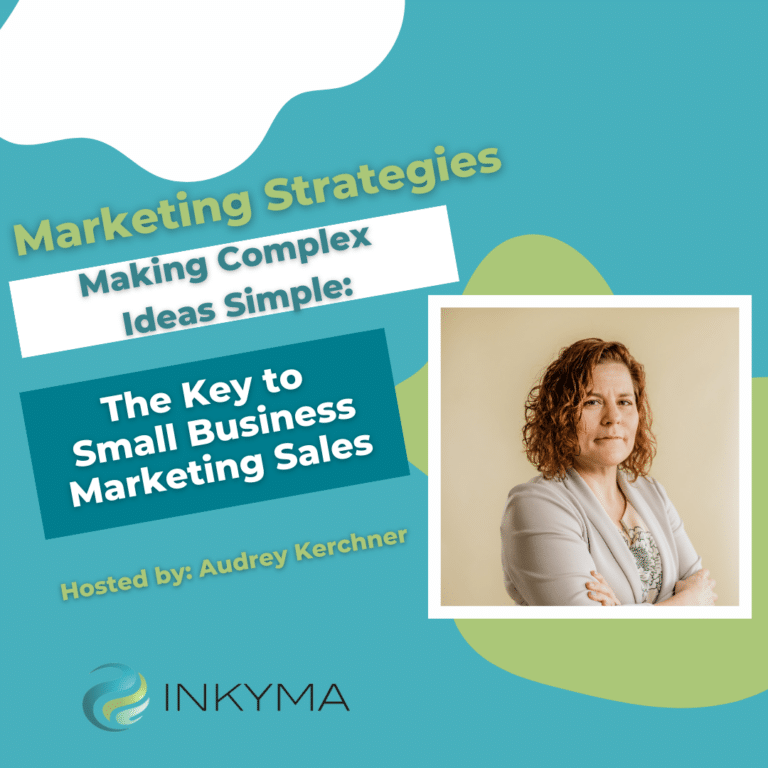Making complex ideas simple is the key to capturing your audience’s attention and conveying the value of your business effectively. In this podcast episode, I explain the things that can make your core messaging too complicated as well as explore the importance of breaking down complicated concepts into digestible pieces for potential customers, and discuss how to identify and communicate your core message.
We share some great examples of companies that have done this well and some examples of industries that struggle with this often. Listen to the full episode and walk away with some actionable steps you can take in your business.
Links Mentioned In This Episode
Donald Miller – Story Brand
Articles & Episodes Mentioned in the Podcast
Episode 37- Strong Brand Identity Part 1: The Customer
Episode 38- Strong Brand Identity Part 2: How To Talk To Your Customers For Better Engagement
Episode 39 – Strong Brand Identity Part 3: Branding Visual Identity
Link to article for reference and review of the commercial –
Love our Podcast? Buy us a cup of coffee to help keep creating for you – paypal.me/InkymaMarketingstra
Sign up for our newsletter at marketingmasterminds.co Free marketing educational content with how-to videos delivered to your inbox.
What we discussed:
- What facilitates the complexity
- How to create simple concepts and ideas to improve sales
- Creating Simple and Engaging Content
Making Complex Ideas Simple: The Key to Small Business Marketing Sales Transcript
Is your business’s complexity, making it difficult for potential clients to understand your value? It could be costing you a lot in sales. Today I’m gonna walk you through the challenge of simplifying complex ideas and how you can review and update your core messaging to increase clarity, which is gonna increase sales.
So before we get into this, there’s just some housekeeping stuff I often recommend products, services, software, articles, additional podcast episodes, links to all of those are gonna be in the show notes. And those show notes are on our website at INKYMA.com and there is a rough transcript of the entire episode in there so that you can go and find what you’re looking for pretty quick.
Now we are partners with many different software companies, mostly the ones that we use for our clients and that I recommend, we stand by them. And so being a partner with them, when you use our links, we do get a small commission. These are our affiliate links. So if you’re thinking about using something I talk about, please take a moment, go to the show notes and use our links.
That little bit of money helps us keep creating all of this free content for you.
So if you are in an industry where what you do is complex, it is difficult to explain, it is difficult to get the idea, then you have that challenge of trying to communicate a complex business idea to your customers. And this happens across many, many different industries. And you’re trying to explain it to a layperson, it’s easier for you to have a conversation with a peer or someone else in your industry.
It’s things like technical products, intricate services, innovative solutions, which I categorize those into something that is someone hasn’t seen yet, so they don’t have a frame of reference of how to relate it. Meaning when I say someone is a lawyer, we have a general idea of who that is. But when we have these new concepts out there, like artificial intelligence and chat bots and things like that, not everybody is familiar with what that is.
And some industries that I think struggle the most in this are HVAC professionals. So water heaters,
air conditioners, heating units. It’s something that all homeowners need, but we don’t really understand how it all works. Any type of technology. When I say the words
data analytics, I usually get a glaze over people’s face.
And of course I talked about it before, is artificial intelligence. That’s the latest thing right now as of this recording, is that industry is exploding. We’re all getting a better understanding of what it is, but we’re not quite sure. And then the last one is insurances, all of them. It can be for your home, your auto, your health life.
All of it is pretty, pretty complicated. So how does this complexity happen? How do we confuse our customers?
And there’s barriers in place that actually facilitate this complexity, and so I’m gonna walk you through what those are so that you can start to identify them in your business. The first one is using industry jargon and or technical language. Which is kind of what an industry jargon is. So if you are in hvac, there is jargon that you use, a language of shorthand so that you can communicate faster and easier.
A lot of times this spills over into your communications with clients and then they get confused. The next one is information overload,
explaining too much too soon. So you…most subject matter experts, they can do this. Sometimes, functional medicine doctors do this. It’s too much too soon. And so they’re not really looking for you to make them an expert.
Nine times out of ten, what they’re looking for you to do is guide them through the process and give them what they need at the right time to make their next decision. And this is across all industries. Sales isn’t about over-educating. It’s really about right information, right time to make the next decision.
The next one is lack of clarity, lack of organization and lack of, or having ineffective visual aids. We’ve all seen those, like you see something on a page and you’re like, what is that? It makes no sense to me. A lot of times this happens when you don’t have organization or clarity is that you’re thinking, and then you start speaking in the middle of the thought process.
Yes, but that person’s only hearing it there, and they needed the front end of it for sure. Or you start explaining something, realize that, oh, you forgot something. You circle back to it and think that the person is staying caught up with you when, and actually they’re not. When you know material, it’s easy to bounce around like that, but when you don’t, it’s extremely difficult.
The next one is emotional and or cultural barriers to the industry, to the category of business. You may not be aware that the person that’s looking at your website or talking to your salesperson has some type of an emotional barrier. So a good explanation of this is health insurance. A lot of people have just emotional, mental issues with their
health insurance, maybe not the person that they’re talking to right now, but in the past. And so having a conversation with them or having them read your content about insurance may make it harder for them to understand the message that you’re trying to convey, especially if one of the message is how you simplify things and make it easier for them. You really have to take that into account. A cultural barrier could be they come from a country or a place that doesn’t have the same laws and regulations we have. And so part of the education is helping them understand why they need, in this example, the insurance, right?
It’s required by law. You have to have it, you have to have car insurance. In most states, I think all states now in the
United States, not sure if it’s like that around the world. And then the last one is similar to jargon, but I like pulling it out because sometimes people don’t think it’s jargon.
And I’m even guilty of doing this is using…overusing acronyms and abbreviations. I do it often when I’m talking about
search engine optimization. I’ll swap that term out with SEO. And then I’ll get asked, well, what does SEO mean? And I have to take a step back, remember who I’m talking to, and then try to use the term, even though it’s way longer to say,
slowing it down, making it easier.
So the reason I take time to go through this with you is because when you confuse someone, you’re gonna lose their business. When most people don’t understand something or feel like it’s too complicated, They tend to take longer to make a decision as well as…
or they may not make a decision at all, right?
They may go, you know, I’m just gonna shelve this for now. And then when they finally do get back to it, they have the energy, the brain power. You know, they had a good cup of coffee that day. They may go someplace else, they may not come back to you. So you don’t wanna lose that sale to competition or to mental fatigue.
The other thing may be is they may try to push through, but may never understand the value of what you’re trying to provide. Your differentiator. If it’s too complicated and if they don’t understand, they may not decide to move forward with you. They may not understand what they’re getting, and the value.
So, I wanna give you a couple of companies that have actually really done this well, just so you can really digest the concept a little bit more. So the first one is SpaceX. They are an aerospace manufacturer. They build rockets and they put those rockets in space. Most of us know who SpaceX is because it’s kind of cool. What I like about them when I’m looking at them and analyzing their company, cuz it’s kind of what I do.
They break down complex concepts like rocket reusability and
satellite deployment extremely well. And then they support that with visuals, cuz sometimes visuals can explain it all. You don’t need to know what’s fueling the rocket or what makes it reusable. You just need to see it go up and you need to see it touch back down.
And there are tons and tons of SpaceX videos out there about that. And then satellite deployment, I think that is a non-technical term, meaning satellites go up and they go out. And so as part of what they do is they have the videos, but then they all have very well spoken and easy to understand people that are speaking, like if they’re doing a launch, the people that they’re putting on camera while you’re watching the launch are well spoken.
They don’t talk too fast. They’re not using jargon, and if they are trying to explain something a little more complex, they either have a video or diagram to help you conceptualize it. Like they know that this is complicated stuff and that the rest of us are not rocket scientists. They also use analogies, which I think is amazing.
I use analogies a lot when I’m trying to explain technical things to my clients and my potential clients. You know, relating what you are talking about to something that is commonplace, that most people know what it is, makes it very easy for them to understand. And I see the light go in people’s eyes when I use analogies.
That’s one of the things you wanna look for when you’re talking to someone, is do they go… does that light of understanding come up? Do they go, oh yeah, I get that.
The next one is, Palantir Technologies. Right? I wanna make sure I said that right. And they are data analytics. They are AI powered operations, artificial intelligence. They have dove deep into that. And so what they do is, instead of trying to explain to you what the AI does or how you analyze data, right?
Because the rest of us, unless we’re data analysts, we don’t want to know that. At least I know, I don’t wanna know that. They focus on the value that they provide, not what they do with the data. So they use terms like enhancing security,
improving decision making, and streamlining operations. So for those of us that are
business owners, if you’re in the C-suite, if you’re a VP or a Director, those are things that you care about, right? Streamlining, making more money, improving decision making things get done quicker. Security you are shoring up your vulnerabilities. Those are all things as business owners, we’re like, yeah, we can get behind that.
Don’t care how you do it. I just wanna know that you do it. It. The other thing they do, which is similar to SpaceX, is they’re creating straightforward visuals and they’re using very clear, simple language to explain this. Like I had said above, they also provide case studies. So when I say, yeah, that’s all great, as long as it works, as long as it’s done well, that’s what case studies do, is they show us an example of how you’ve already done this, who you’ve done it for.
Doesn’t have to be named, and then what the outcome was. It’s the story of how they helped another company or customer. Now if you check out their website, you’ll see it is extremely simple. There’s a lot of white space. When they do have copy in there, it is chunked out, a sentence, a phrase, and it makes it easier to understand.
They really took a lot of time to try to simplify this and you know, the people that they’re selling to are going to be people that understand technology a little bit better, but they start with the message being very simple, very clear what they do, and then they can get down into the weeds once they’ve assessed who they’re talking to and their level of understanding of what all of this is.
Okay, so now let’s talk about how you’re gonna create simple concepts and ideas that will improve your sales. And this is getting back to core messaging basics, which is part of your brand. I did a three part branding series quite a while ago, still very relevant. And so those links are in the show notes.
So this is the part of your brand that is not visual based. It is your messaging. And what that messaging should be is,
how do you solve your customer’s problem, which means you have to know what their problem is and identify the words that resonate with them about those problems. Very, very similar to what Palantir did when I was talking a moment ago about enhanced security, improved decision making, and streamlining operations as a business owner.
Those are things that, you know, I struggle with. And may want help with and I may need help…but if I’m a $10 million, $15 million company, $1 billion company, that is a much more complex problem for someone like me. So that’s where understanding your customer, the level of their problem, and then making sure you right fit that solution.
And so that’s how you’re gonna build your core message around that. And the way I recommend doing it, the way we do it for our customers is we create a brand script, which is just telling the customer story from their perspective, not yours, from theirs. So imagine they’re sitting in front of you and if they were gonna write their story out, that’s really what your brand script is.
The brand script concept is part of the StoryBrand methodology created by Donald Miller. If you’re not familiar with it, there’s a link in the show notes to the book about StoryBrand. Really simple. Great read, and you know, it’s a really effective way to understand how to get inside of your customer’s head.
So now let’s talk about what are you gonna do with that core messaging. So it needs to be at the heart of all of your content. So we’re talking website, blog posts, social media, your videos, and then in your sales presentation and your sales team’s narratives, in their scripts, in any type of documentation that you’re giving to them to use as sales aids, it needs to be in there.
And so some best practices on simplifying these complex ideas, in the context of content formatting is you wanna keep that content short and concise in most places. So the purpose of all of your marketing is to get them to take action, and that first action is either to schedule a time with a salesperson to call you, to fill out a form, even if it’s just a sign up for a newsletter.
That’s what it is. It’s not to make that sale. Unless you’re in e-commerce and you’re selling directly, that’s a little bit different. But for most service-based businesses and even some commerce, you’re selling a product. You can’t sell it right out of the gate. There needs to be some interaction. And so what you want is to create that language so that you’re getting that interaction, not making the sale.
They don’t need to…
and again, going back to overload. They don’t need to know all of it right now. They need to know just enough to make the decision to reach out and have a conversation. So blogs are the exception to this short content idea. They’re supposed to be longer. This is where your long format content is. Each blog article, a thousand words, 1500 words can be more, no problem with it being more: 3,000, 5,000 depending on what you’re trying to do. I would take something like that and maybe break it down into two things and backlink them to each other. But with blogs, there’s an art to the layout. You wanna make it scannable and make it easy to find the content that they’re looking at.
So more headers, not less. You want a table of contents, even for a 1,000 to 1,500 words bullet or bracket, or pull out content so it makes it easier to skim, because then once they get it conceptually how they like to consume content, then they’re gonna take that action. Videos, don’t bury the lede. I see a lot of videos these days,
it’s kind of a trend,
and it kind of annoys me where they’ll tell you in the beginning, oh, I’m gonna tell you about this, and then they wait all the way until the end before they actually give you that meat. What you decided to start watching it for, I like following a traditional newspaper story writing concept where you tell them what you wanna tell them, then you give details about it, then you tell them what you wanted to tell them again.
So this is back in the day of newspapers where they would write it and they knew people would read the first opening paragraph and they would read the last to make the decision whether or not they were gonna. Read what was in the middle. And so I think if we do videos in that way, I think you’re gonna get a better reaction, more engagement, because you’re not creating the video so that they stay longer. Create authentic engagement, which means you’re giving them exactly what they need, when they need it. If it’s a longer video, right? If it’s 20, 40 minutes or longer, then utilize YouTube’s chapters and put chapters and break up the video so that they can bounce around if they need to.
Okay, so now it is time for you to take some action. Test your core messaging. That is your key takeaway for today. From all of this information. You, your salesperson, try to explain it to someone that knows nothing about your business, that they could be a customer, potential customer, not someone who works in your business, anybody else. Do they get it? If yes, great, then you know that you maybe just need some small tweaks, but if they don’t get it, they don’t understand, then you know you need to kind of overhaul your messaging a little bit. Or a lot, a bit, depending on how confused they were. Ask ’em to look at your website.
And see if they can understand what it’s about, what it is that you do, or more importantly, who do you help? What problem do you solve? Ask those specific questions like, Hey, look at my website and tell me what problem I solve. If they don’t know, then you know your messaging is off. Another thing that you can look out for is if you’re having a lot of conversations with people, maybe you’re networking, your sales team is out talking to people, is if they get comments, like, I don’t understand what that means.
Like when I was talking about, when I used the term SEO too much. Or they’re asking extremely simple questions when you’re trying to explain something to them, meaning in the scale of depth you’re here and they’re asking you questions like way up at the top, then you know you need to kind of take a step back and reseimplify things for them.
It’s a sign that your message is a little overcomplicated. So then once you’ve redone your core messaging, or if you found that your core message is on point, double check and make sure it’s on point everywhere. Or update it everywhere. Start with your website. That is the hub of all your marketing communications.
Everything should be driving them back to someplace on your website. Then once that’s updated, if you’re doing digital ads, make sure they are on point. You’re spending a lot of money on digital advertising and you wanna maximize that spend. So make sure your messaging is on point. Then look at your email marketing, your email processing.
It could be your newsletter, could be any type of automations you’re doing if you’re doing sales funnels, you know, if you’re doing digital ads into sales funnel, follow that whole process through. If you’re a commerce type of site and you have abandoned shopping cart emails, check those too.
Any type of welcome messages for when they come into your newsletter. Then you can look at not updating existing social media posts. I think that’s too much work for very little return, but just be cognizant of how you’re creating those posts or how your team is creating those posts going forward. Make sure they have your brand script and they understand your core messaging and how that needs to be conveyed.
And then if you have some really popular videos, you go back and rewatch them and you’re like, wow. I want this to kind of reflect the new core messaging. Add some edits to it. You can just add some simple text to kind of clarify and explain things that is totally acceptable. It doesn’t have to be super polished.
So here are my final thoughts for you on this one. Figuring out how to create marketing messaging and content for a complex subject is really hard, even for marketing professionals, especially if they’re not branding professionals and thinking this way, the way that, you know, I’ve discussed here with you in this episode.
So if you feel like you aren’t sure you want some help, maybe the person that’s doing some of your content creation now, they’re not a branding expert, so they’re not gonna understand how to help you make this shift. Let’s have a conversation. This is one of the core things that we do here at INKYMA is branding.
Full branding packages, but also deep diving into that target audience, core messaging and those values, and understanding who your customer is and how to talk to them. I’d love to have that conversation with you. Here at INKYMA, we love to give back to the business community, and we do it in a bunch of different ways now. I have a 45 minute consultation. I’ve always had that. Just go to INKYMA.com and click on the marketing evaluation button in the upper right hand corner. You’ll schedule a time and we can talk about whatever you want. Branding websites, artificial intelligence. I’m your girl. There’s a contact form on the bottom of every page.
You can just fill that out. They come directly into me. If you’ve got a question, if you have an idea for a show, that would be great. We have the
Marketing Masterminds blog and YouTube channel, and that’s where it’s more hands on content for how to do specific things. Using software, doing a concept. It’s more another layer down.
And then you can also go and sign up for the Marketing Masterminds newsletter and share that. So hopefully you found today’s episode helpful, useful, inspiring for your business. If so, consider sharing it cuz if you are in need of this, then I’m sure you have networking buddies, colleagues, friends, peers that could also use it.
And the purpose of all of this is to help all small businesses grow together. And we do that by sharing content and educating each other. So thanks so much for listening, and I hope you have an amazing day.



























